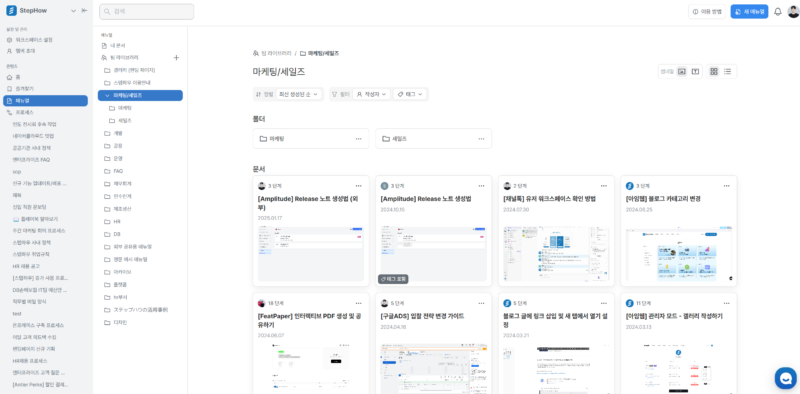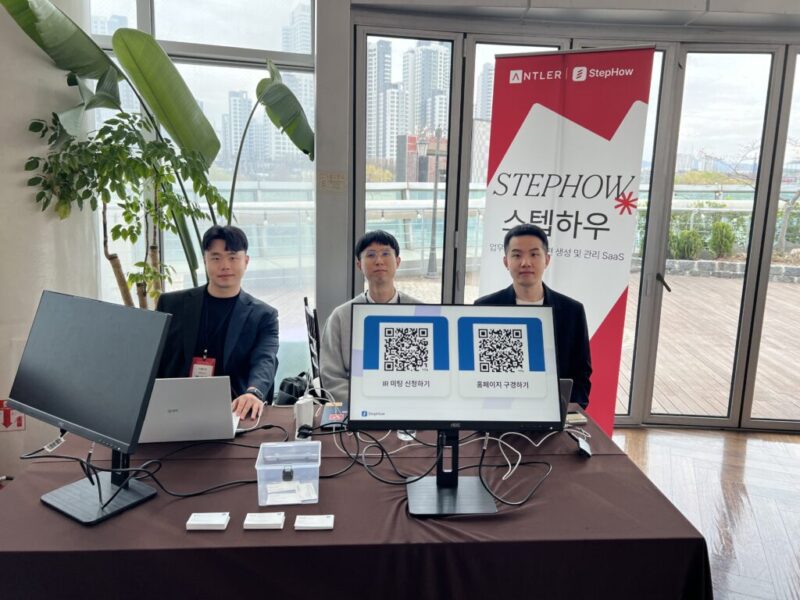[Korean Startup Interview] StepHow, Revolutionizing Workplace Efficiency with AI-Powered Manual Automation
Manuals are vital for any company or organization. In today’s fast-paced world, with new technologies emerging rapidly, their importance is even greater. Without manuals, employees must be repeatedly trained, and when staff changes, the process starts anew, leading to significant workplace inefficiencies.
Creating manuals, however, is labor-intensive. It involves capturing screenshots for every task, compiling them into PowerPoint, circling menu buttons in red, and adding detailed explanations. These must then be converted into separate files and shared. If a task changes slightly, the entire process must be redone, a tedious task most avoid. As a result, beyond a few critical manuals, the vast “tacit knowledge” of employees’ wisdom and expertise remains undocumented.
Recognizing this issue, a startup focused on “manual automation” and “codifying tacit knowledge” was founded. Today’s featured company is StepHow.
StepHow’s website prominently displays: “Don’t explain with words. Create a manual in one minute and share it quickly.” This encapsulates the core of what StepHow does.
How can a manual be created in one minute? It’s simple. Launch StepHow and perform routine tasks—clicking menus, entering data, saving files—as usual. StepHow’s AI observes, recognizing screen movements, button clicks, and text inputs, transforming them into a clear, concise manual. Thus, a manual is completed effortlessly.
This convenient automation is made possible by advances in AI. StepHow’s AI was developed by meticulously studying user behavior patterns, enabling it to understand the significance of natural actions on a computer.

StepHow’s CEO, Sung-wook Hwang, explains, “The idea for automated manual creation stemmed from my own experience. I wondered why repetitive tasks weren’t documented as manuals, which led to StepHow’s development.”
What’s the customer response? Launched in January 2024, StepHow secured seed funding, validating its potential. Despite its brief one-year history, it has acquired over 70 B2B SaaS clients, including major firms like Olive Young, CJ CheilJedang, Daekyo Group, and Remember, as well as public institutions like the Korea Housing Management Corporation, Kyung Hee University, and the Korea Foundation for the Advancement of Science and Creativity. BGF Retail and Dongseo Food use StepHow’s on-premise service, generating nearly USD 71,429 (KRW 100 million) in revenue per client. In April this year, StepHow also recorded sales in the U.S., marking rapid growth.
Contrary to common assumptions, CEO Sung-wook Hwang is not a developer. He previously founded an IT startup and worked in a corporate venture capital (CVC) arm of a conglomerate, handling investments and M&A. Through this, he recognized the potential of automating knowledge management systems (KMS), particularly manuals, leading to StepHow’s creation. The team comprises a CEO with broad business expertise, a CPO specializing in product planning and design, and a CTO focused on software development.
During pre-interview meetings, the WowTale team noted StepHow’s technology but was equally impressed by its quick feedback and exceptional courtesy. These qualities reflect the strengths essential for a B2B IT startup sensitive to client needs.
StepHow is pursuing pre-Series A funding in the first half of this year for a bigger leap. Investors curious about what WowTale experienced with StepHow and CEO Hwang are encouraged to reach out directly via email for a meeting.

What problem is StepHow trying to solve?
Employees document various knowledge, but tacit knowledge—work know-how and experience—is rarely recorded. Creating manuals or processes using capture tools, PowerPoint, or word processors is time-consuming. When tacit knowledge remains in employees’ heads, frequent staff turnover and collaborative work lead to inefficiencies, as knowledge doesn’t circulate.
Without manuals, employees resort to face-to-face questions, calls, or messages to understand tasks. Trainers repeat the same explanations, disrupting their core work. Crucially, verbal knowledge transfer is fleeting, causing handover issues.
StepHow’s Knowledge Management System (KMS) is a solution to collect, manage, and utilize tacit knowledge, enabling employees to easily codify and leverage it using AI as a third-generation AI KMS.

How does it solve this problem?
StepHow is an AI-driven knowledge management solution that simplifies codifying tacit knowledge. Internal knowledge, like “how-to” documents, falls into two categories: system manuals for ERP, MES, or groupware and other documents like internal policies, processes, and FAQs.
Traditionally, creating manuals for systems like SAP or Oracle required capturing screens, pasting them into PowerPoint or word processors, adding red boxes, numbering, and text, then saving as PDFs. StepHow automatically recognizes employee actions—clicks, typing, drags—and converts them into manuals in 30 seconds, over 60 times faster than conventional methods.
For text-based documents like processes or policies, an LLM-based AI-Assistant drafts content from a single prompt. Centralized documents enable seamless collaboration, maximizing search and sharing efficiency, allowing employees to codify, manage, and utilize knowledge in 30 seconds.
What are our competitive advantages and technical strengths compared to competitors?
In Korea, StepHow’s competitors are SI firms that built first-generation KMS, often as internal bulletin boards for large firms and public institutions.
StepHow stands out with user-friendly UX/UI and AI-driven data automation. Compared to global markets, StepHow generates a wider variety of internal knowledge and offers more advanced management and utilization features.
What products/services does StepHow offer, and what is their current status?
StepHow provides a browser extension and desktop program that recognize user actions—clicks, typing, drags—to auto-generate manuals. These manuals support collaborative editing in a web-based workspace with features like sensitive data masking, text box insertion, and auto-numbering.
Sharing options include URL links, HTML copying, MS file conversion, and smart embedding on other platforms. Centralized documents enhance searchability with title and content filters.

What is the target market size, and who are the core customers?
The domestic KMS market is worth USD 714.29 million (KRW 1 trillion), with Asia at USD 10 billion (KRW 14 trillion) and the global market at USD 28.57 billion (KRW 40 trillion), growing at 12.5% annually. Global players like Notion, Guru, and Bloomfire are expanding as post-COVID staff turnover and remote work highlight the value of internal knowledge. AI and Retrieval-Augmented Generation (RAG) technologies have further elevated KMS importance.
StepHow’s core customers are large and mid-sized firms and public institutions with high staff turnover and no established manual systems, where scattered tacit knowledge underscores the need for StepHow’s KMS.
What is our business model?
StepHow offers subscription-based SaaS plans for SMEs and startups. For large firms and public institutions, it provides enterprise plans with on-premise and private cloud options.

What are the StepHow team’s achievements?
Over 70 organizations, including Olive Young, CJ CheilJedang, Umi Construction, Daekyo Group, Remember, Class101, and public entities like the Korea Housing Management Corporation, Kyung Hee University, and the Korea Foundation for the Advancement of Science and Creativity, use StepHow’s SaaS. BGF Retail and Dongseo Food adopted its enterprise model on-premise. Tax, customs, and law firms also utilize StepHow for diverse manuals. Within six months of launch, StepHow generated over USD 28,571 (KRW 40 million) in revenue.
Six months after incorporation, StepHow raised USD 435,714 (KRW 610 million) from Mashup Ventures, The Ventures, and Antler Korea, fueling rapid growth.
What is the StepHow team’s competitiveness?
CEO Sung-wook Hwang, a serial entrepreneur, spent four years in a conglomerate’s CVC handling M&A and venture investments and founded two IT startups. His experience in acquiring IT startups and venture investing gives him deep insight into the venture ecosystem and platform businesses.
CPO Jun-ho Choi specializes in IT service planning, UX/UI design, and AI, while CTO Ji-hyeong Cha, a 10-year full-stack developer, brings expertise from large firms and startups in B2B SaaS, on-premise, SI, and AI projects. StepHow’s full-stack team of B2B solution experts drives its success.

Why should we receive investment? Three reasons!
First, we target the underdeveloped yet innovation-ready KMS market with AI. As AI advances and internal data grows critical, demand for StepHow’s KMS, which preprocesses, manages, and utilizes knowledge, is rising. StepHow is Korea’s first-mover in AI KMS.
Second, we achieved our first U.S. sales in April 2025. AI KMS addresses global corporate knowledge management needs, offering significant international potential.
Third, our team can build vertical AI solutions for large firms. We need investment to R&D the next phase of KMS—“knowledge utilization”—developing an intelligent assistant that integrates with email, collaboration tools, and ERP to search, learn, and provide tailored responses, differentiating us from existing KMS and enabling market leadership.
MORE FROM THE POST
- [Korean Startup Interview] BeringLab: “Expanding Globally with Specialized AI Translation for Law, Patents, and Clinical Fields”
- [Korean Startup Interview] Deepvisions: Revolutionizing Air Pollution Monitoring with AI-Powered Vision Technology
- [Korean Startup Interview] From Text to CAD: How Herewe’s EaseAI Is Revolutionizing Product Design
- [Korean Startup Interview] IPIN LABS, “Challenging the Global Market with Strong Indoor Positioning Technology”
- [Korean Startup Interview] ASTAR, Marketing AI ‘AVICA’ Certified by Major Corporations… Expanding to SMEs and Global Markets





Leave a Reply